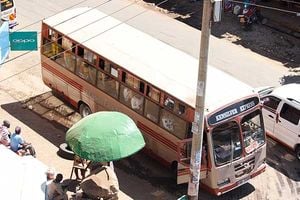Digitisation of Kenyans' identity documents is a step forward

The new driver's licence (right) is a tech leap forward.
A few weeks ago I managed to obtain a digital driver's licence, a tiny wallet-sized plastic card, and this ended 18 years of carrying around a red, faded tattered booklet filled new pages glued in every other year.
The journey to go digital started when a traffic policeman stopped me outside Kilimani Primary School on Argwings Kodhek Road. He asked to see my driver's licence and when I pulled it out, he opened the few pages and said “kijana it is an offence to have a mutilated licence.” He let me off, and I resolved to attend to this.
The process of getting a new licence starts with an application on eCitizen. You then have to link to a different database at NTSA called TIMS, where all vehicle licensing and registration now happens. The bridge is not perfect and it took a few months of emails to get my information located. I then went to the NTSA office where they took my photo and fingerprints.
The licence took a few more weeks to get, though it was supposed to be ready in 5 days. To my relief, while NTSA has hundreds of visitors every day, there were no queues at the times that I was booked in to visit.
The new driver's licence is a tech leap forward. For about ten years, we have admired Rwanda's driver's licence, and now we finally have something like that, instead of faded red booklets which did not seem to show any change since independence.
But behind the scenes, there was a great amount of progress. My first driver's licence was pulled out of a gunia (gurney bag) on a top floor of Times Tower and now in 2021, things have greatly advanced.
The change is great, but it's been a frustrating few years for citizens who spend several days in queues. Early last year, I went to Nyayo House at 3am to apply for a new generation passport. This was just before the Immigration boss drove out to town one night and wondered why idle Kenyans were queuing outside his office. To their credit, the Immigration department introduced a booking system that reduced the numbers there.
But a few months before that, we were retrieving our old documents and looking for the shortest queues to have them scanned into an application for a Huduma Namba. And now we may have to do it all over again as the government loves to make us hurry to comply and then wait for services.
This year will also see more queues to update land title deeds and company beneficial-ownership records. And now we can add one or two queues to get the Covid-19 vaccine which has now landed in the country.
In my wallet now, alongside the new driver's licence card, I have my ID, an NSSF and a NHIF card. Later this year, I may also be issued a new elector's card to vote in the needless referendum. Eventually, we hope the Huduma Namba card will combine every data detail that the government has on us.
Different databases
Clearly, there is little connection between different government departments and their databases, resulting in citizens having to carry several documents around in order to access different services. But the lessons are clear - from Immigration and NTSA; use the databases to manage bookings and this will result in fewer queues and make the government more efficient in providing services.
The driver's licence expires in three years. Unlike the old red book which I could print and stick a renewal page for every year to infinity, this card has no provision for that.
It will be interesting to see what the next renewal exercise will be like in 2024.





